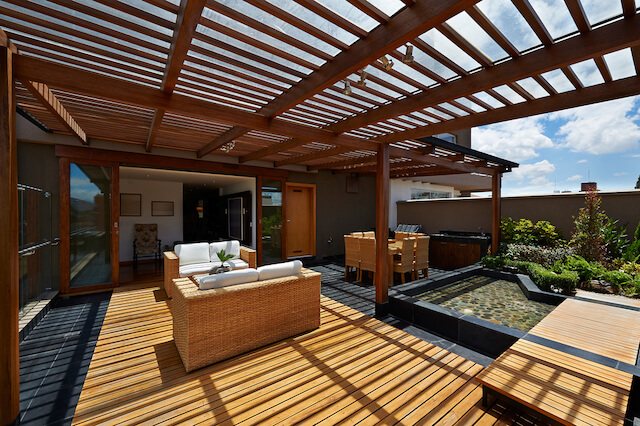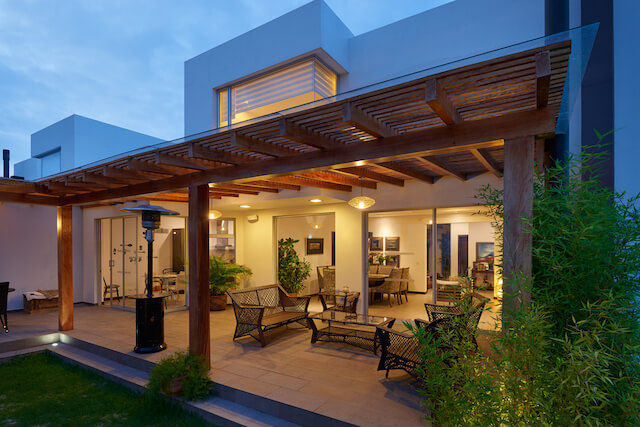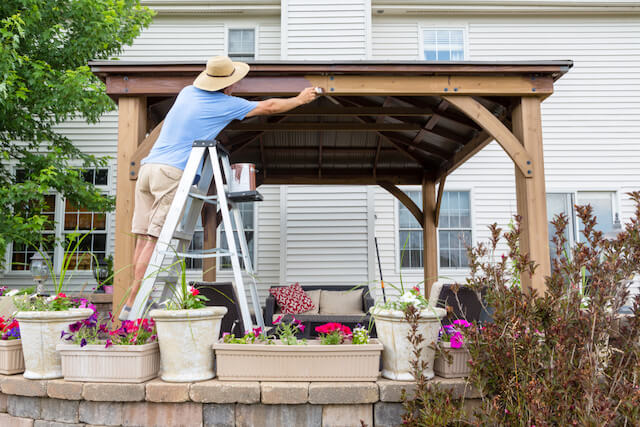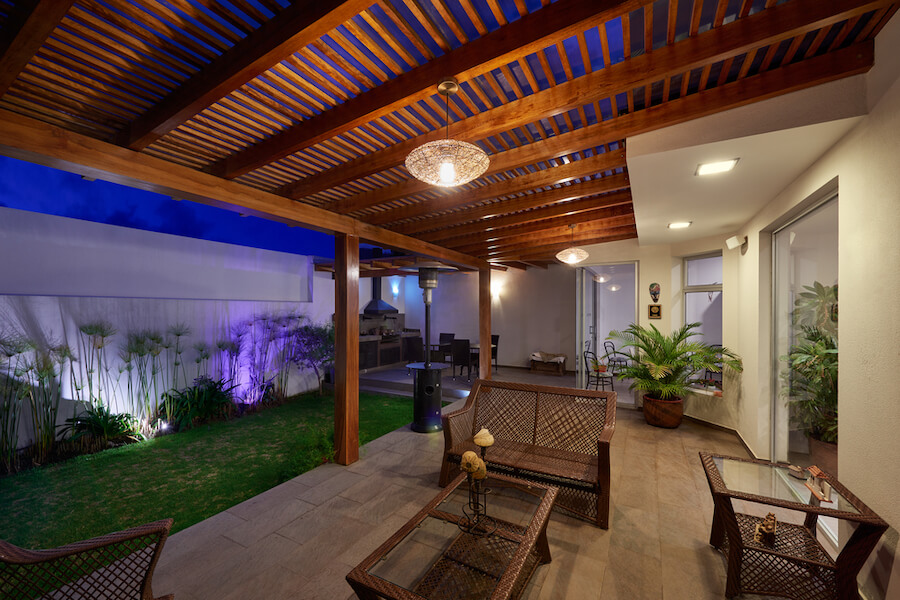A pergola is an excellent addition to the exterior space of any apartment.
In addition to raising the value of your property and taking the beauty of the home to the next level, it allows you to make the most of your outdoor space.
Many apartment owners prefer wood pergolas because they work well in natural settings like gardens. So, you may wonder “Do I need to treat wood for pergola?”
Let’s scroll down to read more right now!
Table of Contents
Do I Need Treated Wood for Pergola?

Treated timber for the pergola is optional but recommended. It will help your pergola beams last long and maintain a glossy look.
Most wood types will turn silver or gray over time. It can deliver a regal look or diminish the vibrance of the structure. Treating wood, including staining, sealing, or painting, will help maintain the beautiful appearance of your pergola.
Staining
Stains are available in transparent, semi-transparent, and solid options.
A transparent stain will protect your wood while keeping as much of the natural tone as it can. But it will color the material and form an entirely new look.
Oak, cedar, or tropical hardwood do not require any stain. Some people opt for staining cedar for an altered color. Meanwhile, you can stain pressure-treated pine to prolong its lifetime.
Painting
Many homeowners are passionate about the natural beauty of wood but prefer to have a little color in their relaxation areas and outdoor entertainment. It is possible to paint over any timber to match your home or deliver an accent color.
We recommend doing some research to choose an outdoor-rated wood paint.
Some paint brands suggest a sealer coat to avoid peeling and fading. Before painting, it is essential to ensure your pressure-treated wood is totally dry.
Depending on your location and when your wood was treated, you can expect the process to last from three months to half a year.
Sealing
Unlike a stain, a sealer coat usually does not penetrate your material or significantly alter its color.
A sealant will work great for pressure-treated oak or pine pergola, while it is optional for cedar and tropical hardwood.
The Best Wood for Pergola Construction

What wood do you need to build a pergola? There are many options on the market, so it is essential to set a few criteria to narrow down your choices.
Your chosen wood needs durability, moisture & insect resistance, and density & scratch resistance.
The good news is that many species of wood are endowed with these beautiful properties by nature, and here are the three best ones.
Tropical Hardwoods
You can consider some beautiful African woods, such as Cumaru, Sapele, and Iroko. They are the ticket to creating a significantly different pergola.
Although they are at the pricier end of the spectrum, they are of great value.
They will help you create a unique, one-of-a-kind pergola that will take your garden landscape to the next level.
Many homeowners choose these woods for their attractive appearance, but they also perform great. They are imbued with top-notch natural durability and impeccable density and strength.
Western Red Cedar
This wood type is one of the most popular options for a pergola. It features a naturally stunning reddish-brown color, making it blend well with almost any outdoor project.
Cedar is native to Canada and has good strength. Most importantly, it possesses a range of important properties that give it natural protection from any element.
It contains many resins and oils, repelling insects, dirt, decay, and rot. So it is ideal for those wet winters. You can leave cedar for a few years without treatment to attain the classic silver color.
European Green Oak
If you are keen on durable, beautiful, on-trend wood that can stand the test of time, you won’t go wrong with sawn oak.
It has been used for structural construction for centuries but is now increasingly attracting the attention of various architects as a versatile wood for buildings.
European Green Oak has all the properties a pergola needs to last. It is strong, durable, and sturdy, with excellent natural resistance to insect infestation, decay, and moisture.
This timber is maintenance-free and can age gracefully to gain a classy silvery gray. But with the occasional application of a precaution, oak pergolas will deliver you many years of high-quality service.
Maintaining and Cleaning a Pergola

If you choose one of the great woods from our list, you can expect your pergola to require low maintenance. The reason is that these woods have natural oils that deliver excellent protection from the elements.
But, all timber will weather to a silvery-gray over time, especially when placed outdoors. If you want your wood pergola to last as long as possible with a glossy finish, consider sealing your pergola with clear oil-based protection.
These transparent preservatives will give your pergola unparalleled weather resistance. We recommend treating your pergola during a dry season when humidity and moisture are low. Just do it every two-to-four years, and your pergola should be fine.
Before treating wood, it is essential to clean it thoroughly first. You can remove all stubborn dirt and stains with a bristle brush, mild soap, and water. Remember to get rid of all debris that accumulates near the grooves.
Regarding mildew, using a combination of mild bleach and water is best. Then, ensure your pergola is completely dry before applying any preservatives.
FAQs
Should I Use Pressure-Treated Wood for My Pergola?
When planning for a pergola, many people are seduced by pressure-treated wood for many reasons.
The most significant benefit is that they are cheaper than any of the woods we’ve listed above.
Remember that they are treated with chemicals that can harm your kids or pets.
Pressure-treated woods tend to have a somewhat unappealing blue & green streaky appearance.
Moreover, they may require frequent maintenance and are not naturally weather-resistant.
Do Pergolas Need to Be Sealed?
Yes. Without treating your wood, it will turn gray over time and will be more exposed to the elements. You’ll want to consider sealing and staining the wood.
What Is the Best Material to Use to Build a Pergola?
Popular material choices in today’s modern pergola market are vinyl, PVC, fiberglass, and aluminum.
How Do You Treat Pergola Wood?
Just spray your pergola with a proper translucent oil-based wood stain.
Then, let the stain dry completely before using a sealant. Carefully read the instructions for your selected stain, paint, or sealant.
Don’t let bird droppings, dirt, and other contaminants build up on your pergola, as they could affect its lifespan.
The Bottom Line
Do I need treated wood for the pergola? It is optional, but periodically treating wood for your pergola is wise to prolong its life.
Maintaining a wood pergola as long as possible with a shiny appearance is the goal of many homeowners. To do that, you must choose a suitable wood and adequately care for/maintain it periodically.
A pergola enhances your home’s value, so give it the best attention!

